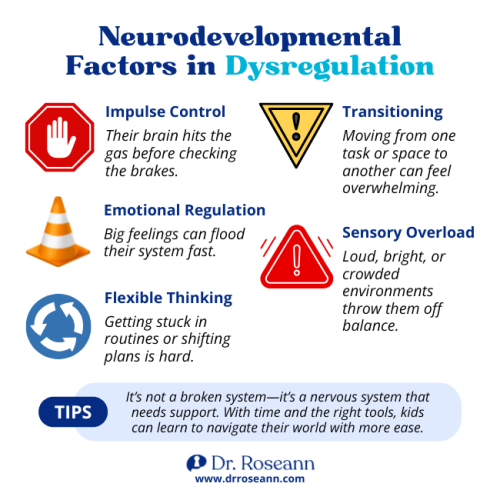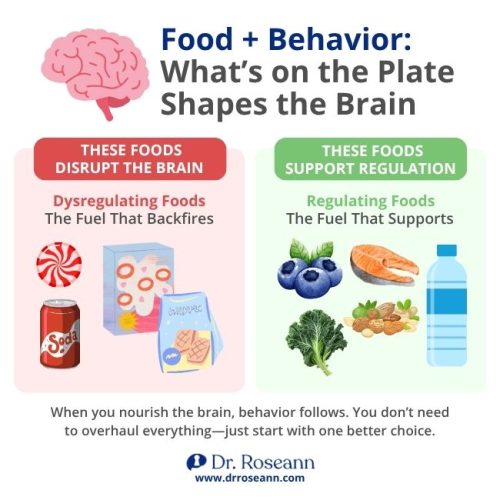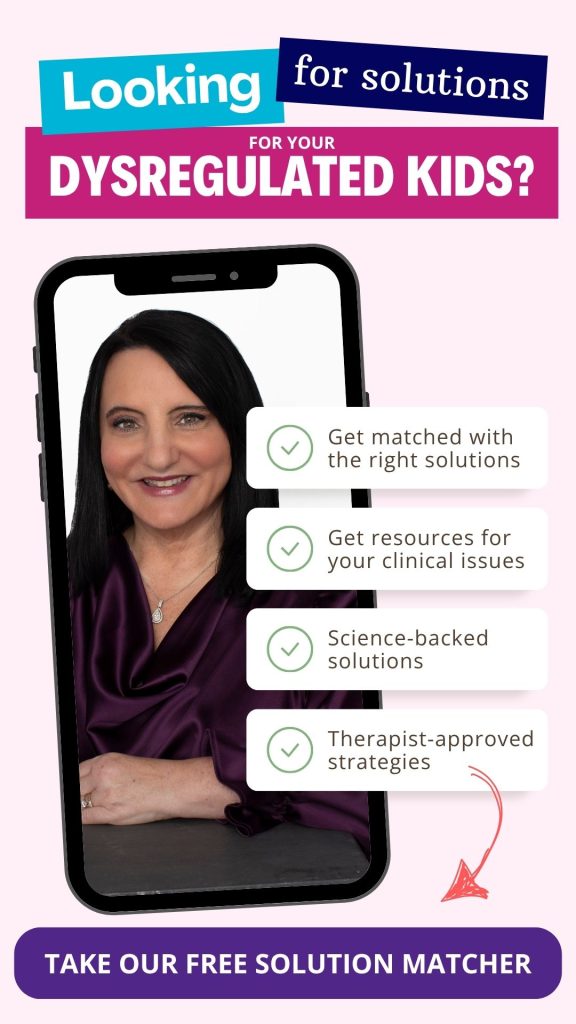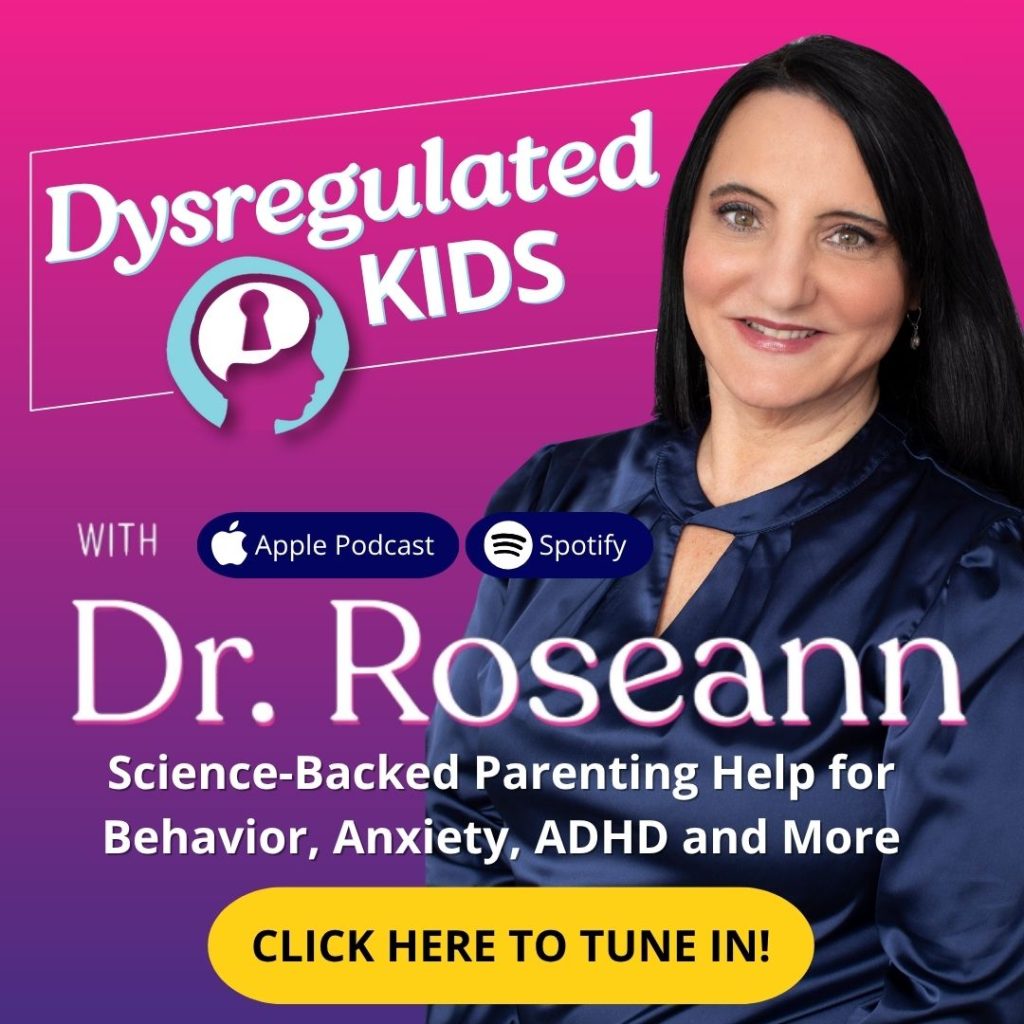Estimated reading time: 12 minutes
If you’ve ever thought, “Why is everything so hard for my child?”—you’re not alone. So many parents come to me feeling worn out and heartbroken, not realizing these struggles often come from deeper brain-based causes of dysregulation.
Here’s the good news: when we stop putting out fires and start looking at why the fires keep happening, that’s when real change begins. Understanding the causes of dysregulation isn’t just helpful—it’s the foundation for helping your child (and your whole family) feel more calm, more connected, and more in control.
Key Takeaways
- Dysregulation—not misbehavior—is often behind emotional and behavioral struggles.
- The brain can’t heal while stuck in survival mode. Regulation begins with calming the nervous system.
- Simple daily shifts help. Think water, movement, sleep, real food, and cutting back on toxins.
- You don’t need to fix it all today. Small steps done often can create lasting change.
- You’re not alone. Many parents feel lost at first—but there’s a clear path, and it starts with the brain.
Psychological Factors in Dysregulated Behavior
Sometimes, it feels like our kids go from zero to sixty for no reason—but there’s always a reason. And a lot of the time, it starts with what’s going on inside: their thoughts, emotions, and how their brain handles stress.
Research shows that kids who struggle with emotional regulation are more likely to face anxiety, depression, or behavior issues over time. In a major study, McLaughlin and colleagues (2011) found that trouble managing big feelings can create a long-term cycle of distress—not just momentary challenges.
Cristofanelli’s 2024 study found that kids with negative thinking patterns—like black-and-white thinking or feeling powerless—are more likely to be emotionally dysregulated. These thoughts can make even small problems feel overwhelming.
So what does this mean for you and your child?
Dysregulation isn’t just about meltdowns or mood swings. It’s often tied to how your child’s brain is interpreting what’s happening around them—and how safe or unsafe they feel inside.
Genetic and Biological Causes of Dysregulation
When a child struggles with big emotions, it’s easy to blame behavior or think they’re just being difficult. But what research shows us — certain kids are wired to be more sensitive because of their genetics.
- One study found that a variation in the serotonin gene (5-HTTLPR) is linked to more intense emotional reactions (Barzman et al., 2015).
- Another showed that differences in how the dopamine system works—specifically a gene called DRD2—can make it harder for some kids to feel good, stay motivated, or manage frustration (Zhylin et al., 2024).
These aren’t just random findings.
Other studies also show that emotional dysregulation isn’t just something a child “grows out of.” It’s often rooted in how their brain is built—and how it reacts to the world around them (Paulus et al., 2021 ; Wei & Peng, 2025). And when we combine those genetic traits with stress or inconsistent support, dysregulation can really take hold.
Read more: Is It in Their DNA? Understanding the Genetic Causes of Dysregulation in Kids
Environmental Triggers for Dysregulation
Sometimes it’s not what’s inside your child—it’s what’s happening around them that throws their nervous system into chaos. We expect kids to “adjust,” but for sensitive or struggling brains, certain environments hit like a tidal wave.
Even everyday things can be too much. Think:
- Buzzing fluorescent lights
- Loud, crowded hallways
- Rapid-fire transitions
- Recess that feels more like battle than break
One by one, these stressors stack up. By the end of the day, your child is emotionally maxed out.
So if they seem “fine” at school but melt down at home? That’s not bad behavior—it’s release. It’s their nervous system unloading everything it couldn’t express earlier.
Their brain isn’t misbehaving—it’s begging for regulation.
“Behavior is the symptom; brain regulation is the solution.” That’s why we don’t just focus on what your child does—we start with what their brain needs.
Read more: Environmental Triggers for Dysregulation: How Your Child’s Surroundings Can Spark Chaos
Neurodevelopmental Factors in Dysregulation

What may look like defiance or drama? Often, it’s just a developing brain trying to make sense of the world. Most days, these kids are doing the best they can with the tools they’ve got—even if those tools aren’t fully built yet.
Impulse control, emotional regulation, and flexible thinking don’t always show up on time—especially for kids wired a bit differently, like those with:
- ADHD
- Learning disabilities
- Autism Spectrum Disorder (ASD)
- Sensory Processing Disorder (SPD)
- Trauma-related dysregulation
Their brains aren’t broken. They’re beautifully different—and still under construction. So when self-regulation lags, even small things can feel really big.
That’s not misbehavior—it’s a brain still figuring things out. The hopeful part? These regulation skills are 100% buildable.
With time, the right support, and a brain calm enough to learn, kids can strengthen those skills just like a muscle.
Regulation unlocks learning, behavior, and emotional growth—it all starts there.
Read more: The Role of Neurodevelopmental Factors in Dysregulation
The Impact of Trauma on Regulation
When a child is constantly dysregulated, trauma is often hiding in plain sight—even when there’s no big “event” to point to. It doesn’t always look like one defining moment… sometimes, it’s a slow drip of stress, sensory overload, or just feeling emotionally alone in a loud world.
What trauma does is rewire the nervous system. The brain shifts into survival mode—and stays there.
- One study found that children with trauma histories had heightened activity in the amygdala (the brain’s fear center), making them more emotionally reactive (Carrion et al., 2007).
- Other research shows that chronic stress alters how the brain regulates emotions—especially in kids with fewer protective relationships (Teicher & Samson, 2016).
These kids aren’t being difficult—they’re overwhelmed. Their brain is signaling, “I don’t feel safe.”
And until a child feels safe, regulation won’t stick. You can’t discipline a child out of dysregulation—you have to co-regulate and rebuild that sense of safety first.
Read more: From Calm to Chaos: How Trauma Affects Regulation in Kids
How Parenting Styles Influence Regulation
When your child is dysregulated, how you respond can either calm the storm or make it worse. And no, it’s not about being the “perfect” parent—it’s about being the anchor in their chaos.
Kids don’t just flip a switch and regulate. They borrow regulation from us first. That’s called co-regulation—when your calm helps their brain feel safe enough to settle.
A 2017 study by Morris and colleagues found that warm, responsive parenting directly supports a child’s ability to manage emotions. In other words, your grounded presence helps build their regulation over time.
So if you’ve been blaming yourself or feeling lost, take this in: You’re not the cause of your child’s dysregulation… But you are the path to their healing. Your calm is their roadmap out.
Read more: Is Your Parenting Style Helping or Stressing Your Child’s Nervous System?
The Role of Stress in Dysregulation
Stress doesn’t just chip away at adults—it hijacks kids’ nervous systems like a thief in the night. And the truth is, most children simply don’t have the internal tools yet to handle that tidal wave of pressure.
When stress sticks around, it rewires the brain’s alarm system to constantly expect danger.
Imagine a smoke detector blaring during a peaceful picnic—no fire, just chaos. That’s what it feels like in their bodies: hyper-alert, overwhelmed, and on edge.
And the impact isn’t just emotional—it’s physical:
- Cortisol floods the system, especially in kids exposed to daily stressors or unpredictability.
- The nervous system becomes sensitized, reacting to even minor changes like a new teacher or forgotten homework.
- This isn’t about misbehavior—it’s about a brain stuck in survival mode, reacting before logic even has a chance to speak (Herts et al., 2012).
To reduce dysregulation, we have to shrink chronic stress and give kids healthy tools to manage it. That’s how we create real change—by calming the brain first.
Behavior is communication. Let’s tune in to what the brain is saying.
Sleep Disruption and Regulation Challenges
Let’s just say this—if your child’s sleep is off, their regulation probably is too. That’s not a coincidence.
Sleep isn’t just rest—it’s deep nervous system repair. And when kids don’t get enough quality sleep, everything from emotional control to impulse inhibition becomes a struggle.
What does overtired look like in kids? Not always yawning or slow-moving—it can show up as:
- Hyperactivity
- Irritability or mood swings
- Defiance or refusal
Here’s the twist—sleep struggles don’t just reflect dysregulation, they fuel it. It becomes a loop that’s hard to break without support.
Most of these kids are running on empty before the day even starts. That’s why sleep isn’t just about health—it’s one of the most powerful and overlooked regulation strategies.
Want to make a shift? Start small. Even one of these can help:
- Create a consistent bedtime and wake time
- Turn off screens at least an hour before bed
- Add magnesium-rich foods (like leafy greens, bananas, or pumpkin seeds)
- Try calming bedtime rituals like meditation, breathwork, or gentle music
When we improve sleep, we help calm the brain.
And when the brain is calm? That’s when real change begins.
Read more: Sleep Disruption and Regulation Challenges
Nutritional Impacts on Regulation

You wouldn’t pour soda into a gas tank and expect the car to run. The brain’s the same—what we feed it fuels behavior.
Foods That Dysregulate:
- Artificial dyes
- Chemical additives
- Processed sugar
These don’t just hype kids up—they hijack focus, mood, and self-control.
Nutritional Deficiencies That Affect Regulation:
- Magnesium – linked to calm and sleep
- Zinc – supports emotional control
- Omega-3 fatty acids – vital for focus and brain communication
If your child melts down by noon or crashes after school, it’s worth peeking into their lunchbox. Nutrition isn’t a side note—it’s a major character in this story.
Simple Swaps That Make a Difference:
- Add more whole foods (fruits, veggies, quality proteins)
- Sneak in brain boosters like nuts, seeds, or wild salmon
- Cut back on bright, packaged snacks—bit by bit
When we nourish the brain, regulation doesn’t feel like a fight. It becomes more natural—like switching from paddling upstream to letting the current carry you.
You don’t need to change everything overnight. Just start with one better choice—and watch the shift begin.
Behavior is the symptom. Brain regulation is the solution. And food? It’s one of the most powerful tools in your toolbox.
Read more: Impacts of Nutrition to Regulation: When Food Becomes Power
How the Lack of Exercise Causes Dysregulation
When kids don’t move, their nervous systems feel the impact.
A sedentary lifestyle throws off the brain’s natural rhythm. Movement isn’t just good for the body—it’s a key part of emotional and behavioral regulation.
Here’s what happens when kids don’t move enough:
- Stress hormones build up
Without regular movement, cortisol stays high. Kids remain stuck in fight-or-flight mode. - Mood chemicals drop
Less serotonin and dopamine means more mood swings and less focus. - The brain stays “stuck on”
Their nervous system can’t shift gears. Transitions become harder and meltdowns more common. - Energy builds with nowhere to go
It shows up as fidgeting, restlessness, or emotional outbursts.
Kids today sit more than ever—at school, on screens, and in cars. That constant stillness takes a toll.
But the fix doesn’t have to be complicated. Even short bursts of movement help reset the brain.
In my 30 years of clinical work, I’ve seen this over and over—movement calms the brain in a way most behavioral strategies can’t.
If you want your child to calm down and feel better, start with the brain. Start with movement.
Environmental Toxins and Nervous System Function
When a child’s nervous system is always on edge, toxins are often part of the picture—even if they’re hiding in plain sight. And no, we’re not just talking about major chemical spills.
Sometimes it’s:
- Mold in the home
- Heavy metals like lead or mercury in food, water, or cookware
- Pesticides on produce
- Fragrances and cleaning products filled with hidden endocrine disruptors
These stressors add up. Toxins build in the body and overwhelm the very systems meant to keep your child regulated.
- Research shows even low-level exposure to common toxins—like pesticides—can affect attention and behavior regulation in children (Bouchard et al., 2010).
- Other studies link mold exposure to inflammation and neurocognitive symptoms we often see in dysregulated kids (Harding et al., 2012).
These kids aren’t misbehaving—they’re overwhelmed. Their brain is screaming, “I can’t process one more thing.”
And until that toxic load lifts, regulation won’t come easy. But here’s the hopeful part: the body is built to detox—when it’s supported.
You don’t have to do it all. Just start somewhere—and always start with the brain.
Parent Action Steps
FAQs
What does it mean when a child is dysregulated?
When a child is dysregulated, their nervous system is stuck in “survival mode.” That means their brain is having a hard time calming down, focusing, or managing big emotions—often leading to meltdowns, anxiety, or defiant behavior. It’s not misbehavior—it’s a brain that’s overwhelmed and asking for help.
Can dysregulation look like ADHD or anxiety?
Yes. Dysregulation can mimic or worsen symptoms of ADHD, anxiety, mood swings, and more. That’s why calming the brain first is so important. Once the nervous system is more balanced, we can better understand what your child truly needs.
Is there hope for change without medication?
Absolutely. While medication helps some kids, many families see lasting progress through natural tools that support brain regulation—like neurofeedback, nutrition, movement, and nervous system calming techniques. Healing is possible when we support the brain in the right way.
What is the root cause of dysregulation?
The root cause of dysregulation is an overwhelmed nervous system that struggles to return to a calm, regulated state. This can happen due to stress, anxiety, ADHD, sensory processing issues, trauma, or medical conditions that keep the brain in “fight, flight, or freeze.”
Citations
Barzan, D., Geise, C., and Lin, P-I. (2015). Review of the genetic basis of emotion dysregulation in children and adolescents. World J Psychiatry 5(1):112-117. https://doi.org/10.5498/wjp.v5.i1.112.
Bernstein, E. E., & McNally, R. J. (2018). Exercise as a buffer against difficulties with emotion regulation: A pathway to emotional wellbeing. Behaviour Research and Therapy, 109, 29–36. https://doi.org/10.1016/j.brat.2018.07.010
Bouchard, M. F., Bellinger, D. C., Wright, R. O., & Weisskopf, M. G. (2010). Attention-deficit/hyperactivity disorder and urinary metabolites of organophosphate pesticides. Pediatrics, 125(6), e1270–e1277. https://doi.org/10.1542/peds.2009-3058
Carrion, V. G., Weems, C. F., & Reiss, A. L. (2007). Stress predicts brain changes in children: a pilot longitudinal study on youth stress, posttraumatic stress disorder, and the hippocampus. Pediatrics, 119(3), 509–516. https://doi.org/10.1542/peds.2006-2028
Harding, C., Ryberg, K., Pytte, C., Nagai, M., Ali, B., & Denisova, K. (2012). 168. Environmental mold, brain inflammation, and memory deficits. Brain Behavior and Immunity, 26, S47. https://doi.org/10.1016/j.bbi.2012.07.192
Herts, K. L., McLaughlin, K. A., & Hatzenbuehler, M. L. (2012). Emotion dysregulation as a mechanism linking stress exposure to adolescent aggressive behavior. Journal of abnormal child psychology, 40(7), 1111–1122. https://doi.org/10.1007/s10802-012-9629-4
McLaughlin, K., Hatzenbuehler, M., Mennin, D., and Nolen-Hoeksema, S. (2012). Emotion dysregulation and adolescent psychopathology: a prospective study. Behav Res Ther, 49(9):544-554. https://doi.org/ 10.1016/j.brat.2011.06.003.
Morris, A. S., Criss, M. M., Silk, J. S., & Houltberg, B. J. (2017). The impact of parenting on emotion regulation during childhood and adolescence. Child Development Perspectives, 11(4), 233–238. https://doi.org/10.1111/cdep.12238
Paulus, F., Ohmann, S., Mohler, E., Plener, P., and Popow, C. (2021). Emotional dysregultion in children and adolescents with psychiatric disorders. A narrative review. Front Psychiatry, 12:628252. https://doi.org/10.3389/fpsyt.2021.628252
Teicher, M. H., Samson, J. A., Anderson, C. M., & Ohashi, K. (2016). The effects of childhood maltreatment on brain structure, function and connectivity. Nature reviews. Neuroscience, 17(10), 652–666. https://doi.org/10.1038/nrn.2016.111
Wei, M., and Peng, Q. (2025). Hillclimb-casual inference: a data-driven approach to identify causal pathways among parental behaviors, genetic risk, and externalizing behaviors in children. Bioinformatics pp1-12. Retrieved from https://arxiv.org/pdf/2505.06784.
Zhylin, M., Mendelo, V., Bondarevych, S., Kokorina, Y., and Tatianchykov, A. (2024). Genetic basis of emotional regulation: integrative analysis of behavioral and neurobiological data. https://doi.org/10.21926/obm.neurobiol.2404256.
Always remember… “Calm Brain, Happy Family™”
Disclaimer: This article is not intended to give health advice and it is recommended to consult with a physician before beginning any new wellness regime. *The effectiveness of diagnosis and treatment varies by patient and condition. Dr. Roseann Capanna-Hodge, LLC does not guarantee certain results.
Are you looking for SOLUTIONS for your struggling child or teen?
Dr. Roseann and her team are all about science-backed solutions, so you are in the right place!
©Roseann Capanna-Hodge










